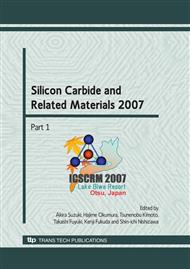p.301
p.305
p.309
p.313
p.317
p.321
p.325
p.329
p.333
Evolution of Basal Plane Dislocations during 4H-SiC Epitaxial Growth
Abstract:
The evolution of basal plane dislocations (BPDs) in 4H-SiC epitaxy during its growth is investigated by using two types of interrupted growth in conjunction with ultraviolet photoluminescence (UVPL) imaging of the dislocations. For the first, each epitaxial growth was stopped after 10-20 μm and a UVPL map was collected. For the second, changing the gas flow interrupted the growth and the BPDs were imaged at the end. The first sequence made it possible to track the formation of half-loop arrays and show that they arise from BPDs that glide perpendicular to the offcut direction. For both types, each interruption causes between 30 – 50% of the BPDs to be converted to threading edge dislocations (TEDs). This result suggests that using interrupted growth may be an alternate method to producing epitaxial layers with low BPD concentration.
Info:
Periodical:
Pages:
317-320
Citation:
Online since:
September 2008
Price:
Сopyright:
© 2009 Trans Tech Publications Ltd. All Rights Reserved
Share:
Citation:


